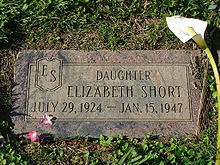"The Black Dahlia" was a nickname given to Elizabeth Short (July 29, 1924 – c. January 15, 1947), an American woman who was the victim of a much-publicized murder in 1947. Short acquired the moniker posthumously from newspapers in the habit of nicknaming crimes they found particularly lurid. It may have been derived from a film noir murder mystery, the title of which alluded to a Dahlia of a different color, The Blue Dahlia, released several months before, in April, 1946. Short was found mutilated, her body sliced in half at the waist, on January 15, 1947, in Leimert Park, Los Angeles, California. Short's unsolved murder has been the source of widespread speculation, leading to many suspects, along with several books and film adaptations of the story. Short's murder is one of the oldest unsolved murder cases in Los Angeles history.
On the morning of January 15, 1947, the nude body of Elizabeth Short was found in two pieces on a vacant lot on the west side of South Norton Avenue midway between Coliseum Street and West 39th Street (at 34.0164°N 118.333°W) in Leimert Park, Los Angeles. Local resident Betty Bersinger discovered the body about 10:00 am, as she was walking with her three-year-old daughter; Bersinger at first thought it was a discarded store mannequin. When she realized it was a corpse, however, she rushed to a nearby house and telephoned the police.
Short's severely mutilated body was completely severed at the waist and drained entirely of blood. The body also had obviously been washed by the killer. Short's face had been slashed from the corners of her mouth to her ears, creating an effect called the Glasgow smile. Short also had multiple cuts on her thigh and breasts, where entire portions of flesh had been sliced away.The lower half of her body was positioned a foot away from the upper, and her intestines had been tucked neatly under her buttocks. The corpse had been "posed", with her hands over her head, her elbows bent at right angles, and her legs spread. Nearby, the detectives found a cement sack which contained droplets of watery blood. There was also a heel print on the ground amid the tire tracks.
An autopsy stated that Short was 5 feet 5 inches (1.65 m) tall, weighed 115 pounds (52 kg), and had light blue eyes, brown hair, and badly decayed teeth. There were ligature marks on her ankles, wrists, and neck. The skull was not fractured, but Short had bruises on the front and right side of her scalp, with a small amount of bleeding in thesubarachnoid space on the right side, consistent with blows to the head.The cause of death was determined to be hemorrhaging from the lacerations to her face and shock from blows on the head and face.
Following Short's identification, reporters from the Los Angeles Examiner contacted her mother, Phoebe Short, and told her that her daughter had won a beauty contest. Only after prying as much personal information as they could from Mrs. Short, did the reporters tell her that her daughter had actually been murdered. The newspaper offered to pay her air fare and accommodations, if she would travel to Los Angeles to help with the police investigation. However, it was again a ploy, since the newspaper kept her away from police and other reporters to protect their scoop. William Randolph Hearst's papers, the Los Angeles Herald-Express and the Los Angeles Examiner, later sensationalized the case: The black tailored suit Short was last seen wearing became "a tight skirt and a sheer blouse" and Elizabeth Short became the "Black Dahlia", an "adventuress" who "prowled Hollywood Boulevard".
On January 23, 1947, a person claiming to be the killer called the editor of the Los Angeles Examiner, expressing concern that news of the murder was tailing off and offering to mail items belonging to Short to the editor. The following day, a packet arrived at the Los Angeles newspaper containing Short's birth certificate, business cards, photographs, names written on pieces of paper, and an address book with the name Mark Hansen embossed on the cover. Hansen, an acquaintance at whose home she had stayed with friends, immediately became a suspect. One or more others would write more letters to the newspaper, signing them "the Black Dahlia Avenger", after the name given Short by the newspapers. On January 25, Short's handbag and one shoe were reported seen on top of a garbage can in an alley a short distance from Norton Avenue. They were finally located at the dump.
Due to the notoriety of the case, over the years more than 50 men and women have confessed to the murder, and police are swamped with tips every time a newspaper mentions the case or a book or movie is released about it. Sergeant John P. St. John, a detective who worked the case until his retirement, stated, "It is amazing how many people offer up a relative as the killer."
Short was buried at the Mountain View Cemetery in Oakland, California. After her sisters had grown up and married, Phoebe Short moved to Oakland to be near her daughter's grave. She finally returned to the east coast in the 1970s, where she lived into her nineties
The Black Dahlia Documentary Video


No comments:
Post a Comment